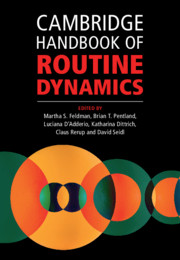Book contents
- Cambridge Handbook of Routine Dynamics
- Cambridge Handbook of Routine Dynamics
- Copyright page
- Contents
- Figures
- Tables
- Contributors
- Preface
- Chapter 1 What Is Routine Dynamics?
- Part I Theoretical Resources for Routine Dynamics Research
- Chapter 2 Practice Theory and Routine Dynamics
- Chapter 3 Process Theorizing and Routine Dynamics
- Chapter 4 Ethnomethodology and Routine Dynamics
- Chapter 5 Pragmatism and Routine Dynamics
- Chapter 6 Actor-Network Theory and Routine Dynamics
- Chapter 7 Materiality and Routine Dynamics
- Part II Methodological Issues in Routine Dynamics Research
- Part III Themes in Routine Dynamics Research
- Part IV Related Communities of Thought
- Author Index
- Subject Index
- References
Chapter 6 - Actor-Network Theory and Routine Dynamics
from Part I - Theoretical Resources for Routine Dynamics Research
Published online by Cambridge University Press: 11 December 2021
- Cambridge Handbook of Routine Dynamics
- Cambridge Handbook of Routine Dynamics
- Copyright page
- Contents
- Figures
- Tables
- Contributors
- Preface
- Chapter 1 What Is Routine Dynamics?
- Part I Theoretical Resources for Routine Dynamics Research
- Chapter 2 Practice Theory and Routine Dynamics
- Chapter 3 Process Theorizing and Routine Dynamics
- Chapter 4 Ethnomethodology and Routine Dynamics
- Chapter 5 Pragmatism and Routine Dynamics
- Chapter 6 Actor-Network Theory and Routine Dynamics
- Chapter 7 Materiality and Routine Dynamics
- Part II Methodological Issues in Routine Dynamics Research
- Part III Themes in Routine Dynamics Research
- Part IV Related Communities of Thought
- Author Index
- Subject Index
- References
Summary
Actor-network theory has always been an inspiring theoretical and methodological source for Routine Dynamics research. Seeing routines as networks of actants and as a consequence rather than a cause of collective action enabled scholars to move away from a priori assumptions about the world and shift their attention to situated performances, multiplicity, and connections-in action. In this chapter, I provide a brief historical account of actor-network theory highlighting some of its central authors and their work before unravelling how Routine Dynamics scholars have appropriated it—ironically, often as an undercover actor that remains invisible at first sight—and conclude by reflecting on how actor-network theory can continue to be of use for and shape Routine Dynamics research.
Keywords
Information
- Type
- Chapter
- Information
- Cambridge Handbook of Routine Dynamics , pp. 73 - 84Publisher: Cambridge University PressPrint publication year: 2021
References
Accessibility standard: Unknown
Why this information is here
This section outlines the accessibility features of this content - including support for screen readers, full keyboard navigation and high-contrast display options. This may not be relevant for you.Accessibility Information
- 5
- Cited by
